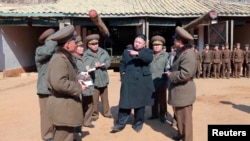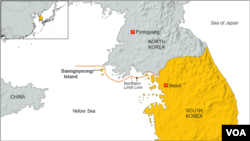SEOUL —
North Korea's official media is quoting its leader, Kim Jong Un, using the most threatening language yet during a visit to a front-line unit poised to attack a South Korean frontier island.
Meanwhile, a major conservative daily newspaper in Seoul quotes a government official saying American nuclear weapons will remain in South Korean waters following current drills, to deter the North.
South Korea's Ministry of National Defense says a fresh threat by North Korea's leader against a frontier island is part of psychological tactics intended to change policy in Washington and Seoul.
Ministry spokesman Kim Min-seok told reporters North Korea is preparing a large-scale military drill later this month, and Kim Jong Un is expected to attend.
The spokesman says the drills could lead to provocation. He says South Korean forces are closely monitoring the North Korean military.
At the top of Tuesday's North Korean radio newscasts were details of the Monday inspection by the country's leader to a coastal detachment said to be ready to attack South Korea's frontier Baengnyeong island.
The announcer quotes Kim Jong Un telling the troops to turn the enemy island into a sea of flames.
The announcer says Kim informed the soldiers that, once his order is issued, to give the “insane enemy” a taste of real war by “breaking their waists and completely cutting their strings of life.”
According to the broadcast, the North Korean leader also specified that the 4th Army Corps should wipe out the island's radar post, artillery defenses, Harpoon anti-ship missiles, rocket launchers and howitzer batteries controlled by the South Korean 6th Marines.
South Korea's semi-official Yonhap news agency says Kim's recent visits to units along the southwestern coast have local observers concerned of another military clash between the two Koreas in the Yellow Sea.
The increasingly bellicose rhetoric from Pyongyang comes amid tighter economic sanctions imposed on it by the United Nations Security Council and the United States, and annual military exercises involving American and South Korean troops.
A major conservative daily in Seoul, the Joong Ang Ilbo, quotes a government official saying U.S. nuclear weapons, likely on submarines, will remain in South Korean waters after the joint defense drills end next month.
The United States removed its nuclear weapons from the peninsula in 1991.
U.S. Forces Korea, asked for a response by VOA, issued a general statement saying the United States “remains steadfast” in its commitment to defend its ally, which includes the extended deterrence provided by “conventional forces and a nuclear umbrella.”
An official at the U.S. Defense Department, speaking to VOA on condition he not be named, denies South Korean media reports that a U.S. aircraft carrier, stealth fighters and B-52 bombers have been participating in the joint annual military exercises in and around South Korea. But the official acknowledges a B-52 Stratofortress performed a "routine continuous bomber presence mission" on March 8, near the Korean peninsula. However, he says the flight was not part of the exercise.
The U.S. Navy is acknowledging the participation of two guided missile destroyers, the USS Lassen and USS McCampbell in the Foal Eagle exercise, which began March 1. According to a Navy officer, the ships are focusing on “training in anti-submarine warfare, air intercept control, communication and command and control.”
A separate overlapping command post exercise, Key Resolve, began this week. It brings some U.S. forces to the peninsula from overseas bases. U.S. officials insist it is purely a defensive training.
Tensions on the peninsula have risen to levels not seen in years.
North Korea contends the current U.S.-South Korean exercises are part of an escalating confrontation against it and a prelude to a nuclear attack, justifying Pyongyang in preparing its own preemptive nuclear strike.
The North has also announced that, effective March 11, it was abrogating the armistice agreement it signed in 1953, along with its allied Chinese military command and opposing U.N. forces.
United Nations spokesman Martin Nesirky says, despite Pyongyang's assertion, the armistice is still in place.
"The terms of the armistice agreement do not allow either side unilaterally to free themselves from it. And, the secretary-general would certainly reiterate the validity and importance of this critical agreement," he said.
South Korean Foreign Ministry spokesman Cho Tai-young told reporters Seoul demands Pyongyang retract the statement claiming to nullify the armistice agreement, as that threatens peace in the region.
Even though South Korea was not a signatory, the spokesman says Seoul will completely abide by the armistice, strengthen cooperation and discussions with the United States and China, sternly responding to any attempt by the North to scrap the agreement.
The armistice has, for the most part, kept a cease-fire in place for the past 60 years. But, the two Koreas have never signed a peace treaty nor normalized relations, meaning they have technically remained at war during the subsequent decades.
Meanwhile, a major conservative daily newspaper in Seoul quotes a government official saying American nuclear weapons will remain in South Korean waters following current drills, to deter the North.
South Korea's Ministry of National Defense says a fresh threat by North Korea's leader against a frontier island is part of psychological tactics intended to change policy in Washington and Seoul.
Ministry spokesman Kim Min-seok told reporters North Korea is preparing a large-scale military drill later this month, and Kim Jong Un is expected to attend.
The spokesman says the drills could lead to provocation. He says South Korean forces are closely monitoring the North Korean military.
At the top of Tuesday's North Korean radio newscasts were details of the Monday inspection by the country's leader to a coastal detachment said to be ready to attack South Korea's frontier Baengnyeong island.
The announcer quotes Kim Jong Un telling the troops to turn the enemy island into a sea of flames.
The announcer says Kim informed the soldiers that, once his order is issued, to give the “insane enemy” a taste of real war by “breaking their waists and completely cutting their strings of life.”
According to the broadcast, the North Korean leader also specified that the 4th Army Corps should wipe out the island's radar post, artillery defenses, Harpoon anti-ship missiles, rocket launchers and howitzer batteries controlled by the South Korean 6th Marines.
South Korea's semi-official Yonhap news agency says Kim's recent visits to units along the southwestern coast have local observers concerned of another military clash between the two Koreas in the Yellow Sea.
The increasingly bellicose rhetoric from Pyongyang comes amid tighter economic sanctions imposed on it by the United Nations Security Council and the United States, and annual military exercises involving American and South Korean troops.
A major conservative daily in Seoul, the Joong Ang Ilbo, quotes a government official saying U.S. nuclear weapons, likely on submarines, will remain in South Korean waters after the joint defense drills end next month.
The United States removed its nuclear weapons from the peninsula in 1991.
U.S. Forces Korea, asked for a response by VOA, issued a general statement saying the United States “remains steadfast” in its commitment to defend its ally, which includes the extended deterrence provided by “conventional forces and a nuclear umbrella.”
An official at the U.S. Defense Department, speaking to VOA on condition he not be named, denies South Korean media reports that a U.S. aircraft carrier, stealth fighters and B-52 bombers have been participating in the joint annual military exercises in and around South Korea. But the official acknowledges a B-52 Stratofortress performed a "routine continuous bomber presence mission" on March 8, near the Korean peninsula. However, he says the flight was not part of the exercise.
The U.S. Navy is acknowledging the participation of two guided missile destroyers, the USS Lassen and USS McCampbell in the Foal Eagle exercise, which began March 1. According to a Navy officer, the ships are focusing on “training in anti-submarine warfare, air intercept control, communication and command and control.”
A separate overlapping command post exercise, Key Resolve, began this week. It brings some U.S. forces to the peninsula from overseas bases. U.S. officials insist it is purely a defensive training.
Tensions on the peninsula have risen to levels not seen in years.
North Korea contends the current U.S.-South Korean exercises are part of an escalating confrontation against it and a prelude to a nuclear attack, justifying Pyongyang in preparing its own preemptive nuclear strike.
The North has also announced that, effective March 11, it was abrogating the armistice agreement it signed in 1953, along with its allied Chinese military command and opposing U.N. forces.
United Nations spokesman Martin Nesirky says, despite Pyongyang's assertion, the armistice is still in place.
"The terms of the armistice agreement do not allow either side unilaterally to free themselves from it. And, the secretary-general would certainly reiterate the validity and importance of this critical agreement," he said.
South Korean Foreign Ministry spokesman Cho Tai-young told reporters Seoul demands Pyongyang retract the statement claiming to nullify the armistice agreement, as that threatens peace in the region.
Even though South Korea was not a signatory, the spokesman says Seoul will completely abide by the armistice, strengthen cooperation and discussions with the United States and China, sternly responding to any attempt by the North to scrap the agreement.
The armistice has, for the most part, kept a cease-fire in place for the past 60 years. But, the two Koreas have never signed a peace treaty nor normalized relations, meaning they have technically remained at war during the subsequent decades.














